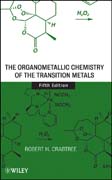
A variety of industrial processes rely on organometallic chemistry, and its applications are prominent in natural product synthesis, pharmaceuticals, polymers, and materials science. Fully updated and expanded to reflect recent advances, the fifth edition of the classic text provides students and professional chemists with a comprehensive introduction to the principles and general properties of organometallic compounds and includes practical information on reaction mechanisms and contemporary applications. With an increased focus on organic synthesis applications, nanoparticle science, and green chemistry, the new edition brings the entire subject up to date. INDICE: Acknowledgment. Preface. List of Abbreviations. 1. Introduction. 1.1 Why Study Organometallic Chemistry? 1.2 Coordination Chemistry. 1.3 Werner Complexes. 1.4 The Trans Effect. 1.5 Soft versus Hard Ligands. 1.6 The CrystalField. 1.7 The Ligand Field. 1.8 Back Bonding. 1.9 Electroneutrality. 1.10 Types of Ligand. 2. General Properties of Organometallic Complexes. 2.1 The 18-Electron Rule. 2.2 Limitations of the 18-Electron Rule. 2.3 Electron Counting in Reactions. 2.4 Oxidation State. 2.5 Coordination Number and Geometry. 2.6 Effects of Complexation. 2.7 Differences between Metals. 2.8 Supramolecular Chemistry. 3. Metal Alkyls, Aryls, and Hydrides and Related s-Bonded Ligands. 3.1 Transition Metal Alkyls and Aryls. 3.2 Related s-Bonded Ligands. 3.3 Metal Hydride Complexes. 3.4 sigmaComplexes. 3.5 Bond Strengths for Classical sigma-Bonding Ligands. 4. Carbonyls, Phosphine Complexes, and Ligand Substitution Reactions. 4.1 Metal Complexes of CO, RNC, CS, and NO. 4.2 Phosphines and Related Ligands. 4.3 Dissociative Substitution. 4.4 Associative Substitution. 4.5 RedoxEffects, The I Mechanism, and Rearrangements in Substitution. 4.6 Photochemical Substitution. 4.7 Steric and Solvent Effects in Substitution. 5. Complexes of p-Bound Ligands. 5.1 Alkene and Alkyne Complexes. 5.2 Allyl Complexes. 5.3 Diene Complexes. 5.4 Cyclopentadienyl Complexes. 5.5 Arenes and Other Alicyclic Ligands. 5.6 Metalacycles and Isolobal Replacement. 5.7 Stability of Polyeneand Polyenyl Complexes. 6. Oxidative Addition and Reductive Elimination. 6.1 Concerted Additions. 6.2 SN2 Reactions. 6.3 Radical Mechanisms. 6.4 Ionic Mechanisms. 6.5 Reductive Elimination. 6.6 s-Bond Metathesis. 6.7 Oxidative Coupling and Reductive Fragmentation. 7. Insertion and Elimination. 7.1 Reactions Involving CO. 7.2 Insertions Involving Alkenes. 7.3 Other Insertions. 7.4 a, b, g, and d Elimination. 8. Nucleophilic and Electrophilic Addition and Abstraction. 8.1 Nucleophilic Addition to CO. 8.2 Nucleophilic Addition to Polyene and Polyenyl Ligands. 8.3 Nucleophilic Abstraction in Hydrides, Alkyls, and Acyls.8.4 Electrophilic Addition. 8.5 Electrophilic Abstraction of Alkyl Groups. 8.6 Single-Electron Transfer Pathways. 8.7 Reactions of Organic Free Radicals with Metal Complexes. 9. Homogeneous Catalysis. 9.1 Alkene Isomerization. 9.2 Alkene Hydrogenation. 9.3 Alkene Hydroformylation. 9.4 Hydrocyanation of Butadiene. 9.5 Alkene Hydrosilylation and Hydroboration. 9.6 Coupling Reactions. 9.7 Organometallic "Oxidase" Reactions. 9.8 Surface and Supported Organometallic Catalysis. 10. Physical Methods in Organometallic Chemistry. 10.1 Isolation. 10.2 1H NMR Spectroscopy. 10.3 13C NMR Spectroscopy. 10.4 31P NMR Spectroscopy. 10.5 Dynamic NMR. 10.6 Spin Saturation Transfer. 10.7 T1 and the Nuclear Overhauser Effect. 10.8 Isotopic Perturbation of Resonance. 10.9 IR Spectroscopy. 10.10 Crystallography. 10.11 Other Methods. 11. Metal-Ligand Multiple Bonds. 11.1 Carbenes. 11.2 Carbynes. 11.3 Bridging Carbenes and Carbynes. 11.4 N-Heterocyclic Carbenes. 11.5 Multiple Bonds to Heteroatoms. 12. Applications of Organometallic Chemistry. 12.1 Alkene Metathesis. 12.2 Dimerization, Oligomerization, and Polymerization of Alkenes. 12.3 Activation of CO and CO2. 12.4 C-H Activation. 12.5 Organometallic Materials and Polymers. 13. Clusters, Nanoparticles, Materials, and Surfaces. 13.1 Cluster Structures. 13.2 Structures. 13.3 TheIsolobal Analogy. 13.4 Nanoparticles. 13.5 Giant Molecules. 13.6 Organometallic Materials. 14. Applications to Organic Synthesis. 14.1 Catalyzed Carbon-Carbon and Carbon-Heteroatom Bond Formation. 14.2 Metathesis. 14.3 Rhodium Carbenes in Cyclopropanation and C-H Insertion. 14.4 Hydrogenation and Related Reactions. 14.5 Carbonylation. 14.6 Oxidation. 14.7 C?H Activation. 14.8 Click Chemistry. 14.9 Noncatalytic Reactions. 15 Paramagnetic, High-Oxidation-State, andHigh-Coordination? Number Complexes. 15.1 Magnetism and Spin States. 15.2 Polyalkyls. 15.3 Polyhydrides. 15.4 Cyclopentadienyl Complexes. 15.5 f-Block Complexes. 16. Bioorganometallic Chemistry. 16.1 Introduction. 16.2 Coenzyme B12. 16.3 Nitrogen Fixation. 16.4 Nickel Enzymes. 16.5 Biomedical Applications. Useful Texts on Allied Topics. Major Reaction Types. Solutions to Problems. Index.
- ISBN: 978-0-470-25762-3
- Editorial: John Wiley & Sons
- Encuadernacion: Cartoné
- Páginas: 505
- Fecha Publicación: 23/04/2009
- Nº Volúmenes: 1
- Idioma: Inglés
